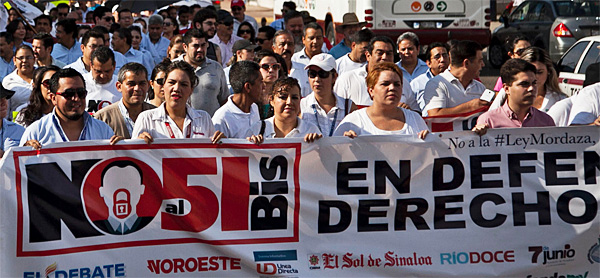Administrators in the Mexican state of Sinaloa are required to backtrack on some disputable enactment this week. The law being referred to precludes columnists from shooting, recording or recording sound at wrongdoing scenes, driving them to depend on official government accounts.
After an overflowing of open dissatisfaction and media dissent, notwithstanding, congressional pioneers have made a guarantee to it will be revoked, pretty much when they come back from excursion.
The law, which was sanction consistently by the state congress on July 30 — however which a few agents have now conceded they didn’t read in full — expresses that just wrongdoing scene data made accessible solely through the lawyer general’s office may be utilized as a part of news records. It likewise bans authorities from identifying with or offering proclamations to columnists.

Powers contended that the measure was vital so Sinaloa can agree to government level legal changes obliging transparent hearings and examinations. The vicinity of news correspondents could modify a wrongdoing scene or prevent an examination, the state contended.
Neighborhood natives and media outlets named the debated article of the Statutory Law for the Attorney General’s Office, which is some piece of a more extensive bundle of related state changes, the “stifler law.” Press rights gatherings reprimanded the measure, especially since Sinaloa is a standout amongst the most wrongdoing ridden states in Mexico and the customary base of the compelling Sinaloa cartel.
“By no means will media outlets be allowed access to wrongdoing scenes, permitted to record sound or feature, or photo individuals included in criminal action, nor might they handle data identified with open security or the obtaining of equity,” expresses the article of the law being referred to.
The scene at the February catch of Joaquín “El Chapo” Guzman, for instance, which happened in the Sinaloa port city of Mazatlán, would have been beyond reach to press under the muffle law.
Joaquín “el Chapo” Guzmán caught in Mexico:
The law was set to go live on October 15. A week after it was sanction, nonetheless, and after a storm of challenges sorted out by columnists in a few real urban communities in the state — including Mazatlán, Culiacán, Guamúchil, Guasave, and Los Mochis — Sinaloa Governor Mario López Valdéz told news outlets that the enactment would be canceled after the authoritative summer break finishes up on Thursday.
Indeed in this way, police in one Sinaloa city seem to have executed the muffle law on their own.
On August 2, three days after the law was passed, police revealed an undercover grave in Los Mochis, a piece of a disturbing string of late disclosures of mass entombment locales in Mexico. The state prosecutor’s office reported that just two bodies were found at the site, however when news people approached the territory to freely affirm the subtle elements of the discover, they were dismissed by powers.
Relatives of individuals who had turned up lost in close-by towns and approached the scene wanting to take in the exploited people’s characters were likewise compelled to stay over a quarter mile far from the scene, neighborhood reports said.
Writers have translated this episode as the first indication of the control and disinformation that could come about because of usage of the muffle law. News associations likewise whined that the law was basically being implemented around six prior weeks it was set to produce results.
“The law would just serve to keep powering exemption and an absence of responsibility and transparency from the commanding voices responsible for looking for equity,” said the free-discourse bunch Artículo 19 in an announcement. “This is a lopsided measure, deserving of a tyrant state.”
Revelation of mass grave in Mexico provides reason to feel ambiguous about nation’s moving number of missing.
As per the Sinaloa government, the stifler law was submitted as a feature of an activity to comply with the modernized legal framework called for in more extensive elected change, which the legislature trusts will streamline lawful incidents.
In 2008, Mexico started an arrangement of changes to the criminal equity framework, changing from an inquisitorial model — in which the charged is dared to be blameworthy, and incidents happen to a great extent in secret — to a US-style antagonistic framework, where the arraignment defies the protection in an oral trial setting.
As of now, Chihuahua, Morelos, and Mexico are the main states in the nation to have completely received the 2008 change, which is situated to go into full impact at all levels by 2016.
For Sinaloa’s situation, lawmakers briskly passed the nearby form, a 47-page report, on the most recent day of session before they punched out for a three-week get-away. A few administrators have since conceded that they didn’t read the whole bill and misgiving having voted in favor of it.
On August 4, as the hullabaloo against the stifler law developed, the Sinaloa government reported that the representative marked an activity to cancelation it, saying it was expected to “ensure victimized people or gatherings influenced by law violations will get equity and have their rights regarded,” and including that “the protecting of wrongdoing scenes and data identified with examinations is key” for this methodology.
“It was shockingly defectively worded. We could call it not extremely precise,” Governor López Valdéz said, alluding to the four-paragraph clause.



